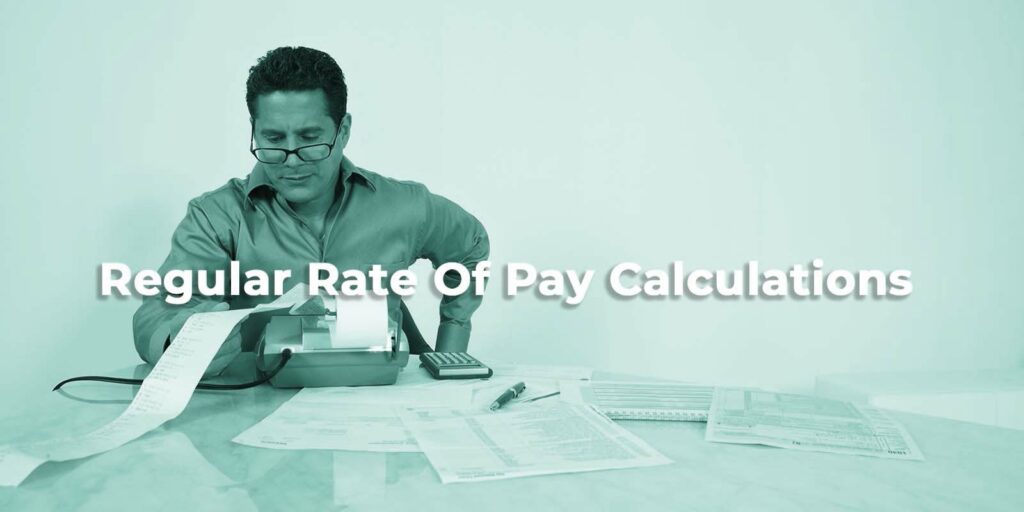What is Regular Pay Rate?
Regular pay rate is the latest and greatest headache to hit Payroll Managers in the state of California. The regular pay rate of an employee is the basis for calculating their overtime and meal-break penalty compensation. Regular rate of pay will only pertain to a non-exempt employee (an hourly rate employee). Any employee that is paid a salary will not fall under this regular rate of pay regulations.
Employers often assume the regular pay rate is an employee’s offered hourly rate, but an employee’s regular pay rate includes their other forms of compensation they receive as an employee, such as non-discretionary bonuses, production bonuses, commissions, piece work earning, and the value of meals and lodging, in addition to their hourly rate of pay.
Forms of compensation that are not included in the calculation of an employee’s regular rate of pay are overtime hours, profit sharing, discretionary bonuses, and expense reimbursements.
When your workers aren’t provided with their meal breaks or are working overtime, it’s more costly than you think.
How To Calculate Regular Rate Of Pay In California:
You’re probably wondering how to calculate an employee’s regular rate of pay now, and also dreading all the retroactive calculations to come.
An employee’s regular pay rate is calculated each workweek, so it can fluctuate week over week. When determining the rate of pay for a week, you will take all the payments an employee received, exclude any payments that aren’t eligible towards the rate of pay, and divide that big number by the number of hours the employee worked.
Let’s say you had an employee that makes $15 per hour and they worked 45 hours last week. In addition, they also received $325 in commissions that week. They received $600 in regular wages (excluding overtime) + $325 in commissions, equalling $925 total for the week. Now we need to figure out how to calculate and include their overtime pay into this total. We would take the total amount of $925 and divide that by 45 hours, equalling $20.56 per hour. The total amount for that employee’s overtime is $20.56 x 1.5 x 5 hours = $154.20 of overtime pay. The employee’s total pay for that week would be $1,079.20.
If we would’ve paid the employee’s overtime rate at their regular rate of pay x 1.5, their total overtime pay would’ve been $112.50, and $1,037.50 for the week. That’s a $41.50 difference for the week, which definitely makes a difference in your account and on the employee’s paycheck.
How To Calculate Regular Rate Of Pay For Overtime:
When it comes to overtime and regular rate, one important factor to remember is non-discretionary bonuses must be calculated into their regular rate. There are two types of bonuses; discretionary and non-discretionary. A non-discretionary bonus is one that the employee has to earn. An example of a non-discretionary bonus would be, a salesperson who receives a bonus for selling a certain amount of product.
This non-discretionary bonus would then be included into the employee’s overtime. For example, Bob earns $10/hour and works 50 hours in the workweek. Bob earns a $1,000 bonus. You would calculate Bob’s regular rate of pay by: [($10/hour x 50 hours) + $1,000 bonus] / 50 hours.
Bob’s regular rate of pay with overtime and his non-discretionary bonus included would be $30 an hour. Bob would be paid $30 an hour once his overtime and bonus were calculated into his regular rate.
Does paid sick time get calculated into the regular rate of pay?
The simple answer is no. Sick time does not get calculated into an employee’s regular rate of pay. Pay for sick time will be separate from the regular rate of pay.
What Happens if an Employer Doesn’t Use the Correct Calculated Wages?
It can be bad news for employers who aren’t calculating and paying their employees’ overtime and meal-break penalties at their regular rate of pay. Lots of businesses are seeing lawsuits for failing to properly pay premiums or overtime rates at the regular pay rate. Another place this is sneaking up on employers is for retroactive time the employer hasn’t been complying. For example, in July 2021, a new law passed that we had to pay employees their regular pay rate for missed meal period premiums which was also stated to be retroactive to January 1, 2021. That means employers had to go back and recalculate employees’ regular pay rate during all the weeks they received meal break premium pay and pay out the balance.
Still, have questions? We don’t blame you! Reach out to your Bizhaven HR Business Partner today to assist with the proper pay calculated on your employees’ pay stubs.



